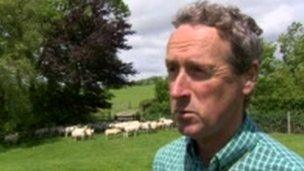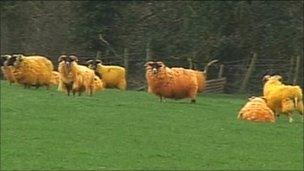Rising meat price tempts sheep rustlers
- Published

Robin Dean's stolen sheep were linked to his flock by DNA testing
When rustlers took 55 sheep from a farm in Lancashire they could not have suspected they would eventually be caught by the latest DNA technology.
Forensic science was used for the first time to link Chipping farmer Robin Dean's stolen livestock to the rest of his flock and reunite them.
The two thieves had transported them to Durham, where a vigilant farmer reported their suspicious sudden appearance.
But until now it has been difficult to prove sheep are stolen property as they all look very similar.
The use of DNA is another of the increasingly high-tech tools in the armoury of farmers, who are suffering increasing numbers of sheep thefts due to the rising price of meat.
Analysis of the DNA of suspected stolen sheep and that of the remaining flock can tell scientists if they are related.
Latest figures from farm insurers NFU Mutual show about 67,000 sheep - double the previous year's tally - were stolen across the UK during 2011 at a cost to the industry of £6m.
Criminals 'very organised'
The retail price of lamb has risen by 34% to £7.77 per kilo since 2007.
In Lancashire 305 sheep, worth £43,000, were stolen in the last 18 months in 20 separate crimes. The sheep stolen from Mr Dean were valued at up to £15,000.
In response, farmers are turning to sophisticated deterrent measures.
Retina scanning is used to register unique patterns in the sheeps' eye and new software is being trialled to photograph unique parts of the sheep in order to be able to instantly identify each animal.
Sheep farmers are not the only ones to employ high-tech theft deterrent measures - cattle passports link them to their parents and the British Cattle Movement Service runs a Cattle Tracing System database to catalogue each animal's details.
National Farming Union (NFU) chief livestock adviser Peter Garbutt said: "There are lots of applications for DNA technology in future and I hope it will deter criminals as at the moment it's difficult to trace the sheep because they all look alike.
"Deterrents like DNA can hopefully slow down the rise in crime but we're also trying to encourage farmers to adopt preventative measures."
Not all deterrent measures have to be costly, as one Dartmoor farmer, John Heard, proved when he dyed all his sheep orange.
This may give criminals second thoughts if they were going to sell the sheep on, but sometimes the sheep are not taken away from their farm to be killed - they are slaughtered on the spot.
"You see everything from sheep killed and butchered on the field to large groups of sheep that disappear without a trace," Mr Garbutt said.
"In one case hundreds were stolen in one go and they just disappeared."
Mr Dean said he believed vigilance is one of the farmer's most important weapons against criminals, adding: "Most people are members of the Farmwatch Scheme to keep each other informed of suspicious goings on.

Farmer John Heard says the bright dye puts off rustlers
"The sheep are what I need to provide my livelihood so it's not the actual value of the individual sheep, it's the fact that they are taking my ability to make a living.
"It's very difficult to actually put sheep under lock and key."
He added: "I went into the field one morning and 55 were missing - it was a shock, I was annoyed someone had come along and taken them.
"We had to prove these were our sheep and to do this they used DNA parentage testing - I think it's obviously another tool in the armoury that can be used to prevent thefts, but the best deterrent is probably vigilance."
Mr Garbutt thinks consumers should be making sure they buy meat from reputable sources.
He said: "Look out for the red tractor logo so you know it's been produced to high standards and you can have confidence in the quality and safety of the meat.
"We do have concerns stolen meat that's sold could be from animals that have recently been treated so they still have medication traces in their system and it's not advisable to eat."
- Published24 August 2012
- Published29 June 2012
- Published14 April 2011